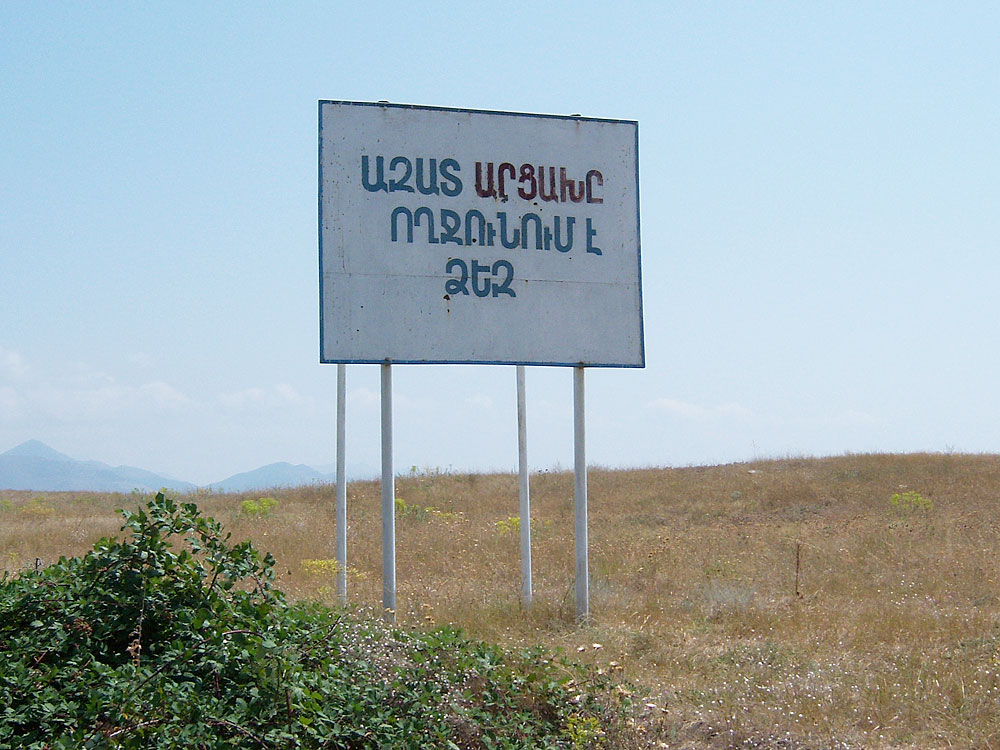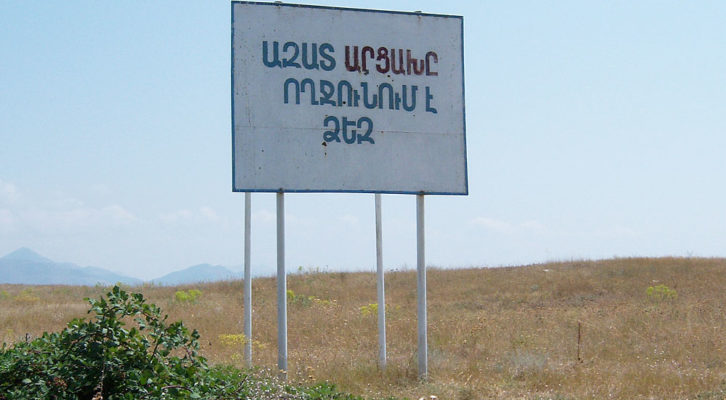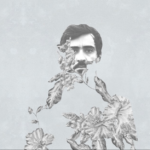I wanted to write about this a long time ago, even before the war. But the Artsakh War, its devastating outcome on the Armenian nation and its political ideology pushed me to raise some provocative questions and arguments. What kind of Artsakh do Armenians dream of? Is there any legal status that defines its institutions and borders? While the war and recent geopolitical developments have narrowed our vision, we must still discuss them.
For me, the status of Artsakh within our national vision has somehow become paradoxical. Even before the 2020 war, many intellectuals both in Armenia and the Diaspora were lecturing the “not a single compromise” narrative and that Armenia has an invincible army that can reach Baku. Some believed this narrative, either because they were convinced that Azerbaijan would not wage such a destructive war, or they were unable to analyze the Russian-Turkish relations in Syria and Libya. Most were not convinced that what has happened in the Middle East and North Africa can be repeated in the South Caucasus. The outcome of the war was a huge shock for them, but also for many of us who believed in this narrative either due to conviction or ideological reasons.
After the war, these same people started to spread the following narrative: “Well, we should have engaged in mutual compromise and moved forward with the Lavrov plan” where, according to Russian Foreign Minister Sergey Lavrov, special status was to be given to Artsakh, and Armenian forces were going to hand over the five adjacent regions to Azerbaijan and keep the Lachin and Karavajar districts until a final status on Artsakh was to be decided after a referendum. Meanwhile, peacekeepers (probably Russian) were going to be deployed in Nagorno-Karabakh. However, both Baku and Yerevan were not ready for a mutual compromise and were blinded by their official narratives. Although this plan was discussed and pushed forward after the 2016 war, if accepted during that time, Armenians could have avoided a major war, isolated Azerbaijan, disallowing Turkey to step into the South Caucasus.
Two other plans were also raised in the 1990s. The first and oldest is the “Goble Plan,” named after the American diplomat Paul Goble, who proposed it back in 1994. This plan is based on the exchange of territories between Armenia and Azerbaijan. The Goble plan envisages the return of liberated areas around the Nagorno-Karabakh Autonomous Oblast (NKAO), as well as the exchange of a part of the Meghri region in southern Armenia (bordering Iran) for the Lachin corridor. As a result, Baku would receive a land connection with Nakhichevan, and Yerevan – with Artsakh. One of the variants of this plan was supposed to compensate Armenia for the loss of access to Iran by handing over to Yerevan a “corridor” to the Iranian border in the west of the Nakhichevan. However many Armenian politicians, including former PM Vazken Sarkissian, warned about this plan and argued that Meghri and the border with Iran are crucial for Armenia’s political existence, and by being surrounded by Turkic countries, Armenia would be squeezed by Turkey.
The other plan was raised by the OSCE, the basis of which was the phased return of the liberated territories, the possibility of bringing in OSCE peacekeepers and the postponed status of Nagorno-Karabakh, which should be decided by the Azerbaijani-Armenian commission with international mediation. In 1998, the idea of creating a confederation was also thrown on the table. This would include Azerbaijan and the Republic of Artsakh on equal terms in a single state. However, both were rejected.

“Free Artsakh welcomes you” sign (Photo: 517design/Wikimedia Commons)
Speaking from our ideology (Free, Independent, and United Armenia), Artsakh, including Shahumian and Kantsag are part of historical Armenia. An internal debate cannot happen on that; however, state policies and statecrafts are based on realism. There are two choices. One is based on idealism and romanticism and the other is based on realism. The fight to restore the 1994 borders of Artsakh at this stage is pure fantasy. The Armenian government has abandoned the national cause of Artsakh, and authorities in Artsakh are unable to take any political decision without a “green light” from the Russians. A realistic outcome in the future would be to fight for the restoration of at least the 1988 NKAO borders plus the Lachin corridor. However, the recent clashes in Syunik and Gegharkunik have proven that without Lachin and Karvajar, the national security of Armenia and its eastern borders would be threatened and Artsakh economically isolated.
Moreover, let us not forget the occupied regions of Nagorno-Karabakh from Shushi, Hadrut or Talish in the northeast. Even during the negotiations, Azerbaijan always demanded a special status for Shushi. With the signing of the June 15 “Shushi Declaration,” the liberation of Shushi is at stake and impossible without Russian direct intervention. At this moment, Moscow has no plans to revise the status quo, unless Baku takes provocative steps that would threaten Russia’s interests in the region. Moreover, to consolidate its power in Shushi and Artsakh, Aliyev is planning to resettle Azerbaijani refugees in the city.
Therefore, can we imagine an Artsakh without its heartland and stronghold Shushi? Shushi is not just an emotional city. It is also a strategic town where the one who rules it can rule over Artsakh. Azerbaijan understood this concept very well.
Painfully, we have to rethink and revise our strategy towards Artsakh. For the past several decades, we kept stressing the “self-determination of Nagorno-Karabakh,” but I believe this slogan in the Diaspora and in our diplomatic and lobbying circles has become a bit of a cliché, and its date has expired. If we continue with this narrative and this trend, if the demographic balance within the 1988 borders of Nagorno-Karabakh changes in Azerbaijan’s favor, we would lose all our efforts to guarantee the security of Artsakh and its Armenian identity. For that reason, we have to work and lobby for the self-determination of the Armenians of Artsakh. However, the outcome of the recent war has changed the balance of power in Azerbaijan’s favor and made Artsakh’s future status more complex.
Three scenarios may arise in the future for the status of Artsakh.
- The Russians may provide an option for Artsakh Armenians to either be part of Azerbaijan and have a special status under Russian security with a land corridor connecting to Armenia. This would satisfy the current leadership of Azerbaijan. Given the current balance of power in the region, which is not in Armenia’s favor, Yerevan must push double-track diplomacy and try to activate the mandate of the OSCE Minsk Group to avoid such a plan at all costs, as the Armenians of Artsakh would not be able to physically and politically survive under Baku’s authoritarian rule.
- Russia could offer the current territories of Artsakh to be part of Armenia in exchange for a peace plan. Will we accept it? Given the loss of Shushi, Hadrut, Talish and the results of the elections, PM Nikol Pashinyan may sell this scenario to the people and present himself as a “peacemaker.” If the people, at least the majority, have the option to choose war or in this scenario painfully avoid a new war, many would vote for this scenario. However, for the time being, Moscow is not ready to solve this conflict.
- Painful as the above scenarios are, Russia may allow itself to swallow the Armenian-populated region of Artsakh and declare a Russian sovereign region, like Abkhazia and South Ossetia. If the Armenians of Artsakh are left with two options – whether to join Azerbaijan or Russia – their choice is clear. But this may trigger a clash between Russia and Azerbaijan.
What Armenians lack today are Machiavellian diplomats who can analyze the weakness of an opponent and maneuver around it. It is clear that the Russians have re-frozen the conflict and imposed the current status quo to prevent further catastrophe with Turkish involvement, thus keeping Turkey outside of the diplomatic track. However, Turkey is in the region. Russians are also there, and they are not planning to leave the region anytime soon. However, it is up to Armenians to abandon their “wait and see” approach and become initiators. The strategy that Armenian leaders engaged in starting in 1994 (except Levon Ter Petrosian) – “let’s postpone the status issue, keep the current status-quo and win some time” – turned out to be catastrophic. We need visionary statist leaders, not populists nor pessimists. We have to come up with a unified vision defining the status of Artsakh and guarantee the security of Armenians living there.
The article was originally published in the Armenian Weekly, 15/9/2021
Yeghia Tashjian is a regional analyst and researcher. He has graduated from the American University of Beirut in Public Policy and International Affairs. He pursued his BA at Haigazian University in Political Science in 2013. He founded the New Eastern Politics forum/blog in 2010. He was a Research Assistant at the Armenian Diaspora Research Center at Haigazian University. Currently, he is the Regional Officer of Women in War, a gender-based think tank. He has participated in international conferences in Frankfurt, Vienna, Uppsala, New Delhi, and Yerevan, and presented various topics from minority rights to regional security issues. His thesis topic was on China’s geopolitical and energy security interests in Iran and the Persian Gulf. He is a contributor to the various local and regional newspapers and presenter of the “Turkey Today” program in Radio Voice of Van. Recently he has been appointed as Associate Fellow at the Issam Fares Institute for Public Policy and International Affairs at the American University of Beirut and Middle East-South Caucasus expert in the European Geopolitical Forum.







